I shamelessly "nicked"this from American Rifleman", I have or *had* 2 Mauser pattern rifles until my dastardly kayak accident *Sniff*Sniff*. Don't get me wrong, I like or liked my semi-auto's, the marvel of modern technology, but there is something about a good old fashioned bolt action Rifle.

Everyone knows the name “Mauser,” and the bolt-action rifles associated with it. Yet, there is far more that goes with the famous name than that. There were already 10 little-known facts covered previously, but thats not all. Here are 10 more facts you may not have known were a part of the Mauser story:
One: The U.S. Military Tried The Mauser, But Had to Be on the Business End Before They Were Convinced
The U.S. Army included Mausers in their 1892 trial to replace the single-shot Trapdoor Springfield. Versions of the Belgian Model 1889, including some modified to fire the rimmed .30 Government (later to be known as the .30-40 Krag) round, were evaluated. Alas, America’s first bolt-action, smokeless cartridge service rifle ended up being the Danish Krag-Jorgensen design.
In a few years, the Army would see the error of their ways when their Krag and Trapdoor Springfield-armed rifleman encountered Mausers on the battlefield. The Spanish-American War brought the U.S. under the sights of Model 1891 and 1893 Mausers, which had a clip-loading system that gave them a distinct firepower advantage over the Krag, which had to be reloaded one round at a time in its side-hinged magazine. The Mauser didn’t turn the tide for the Spanish, however, and thousands of Mausers were captured and brought back to the U.S. where they were sold as surplus through the Bannerman Company.
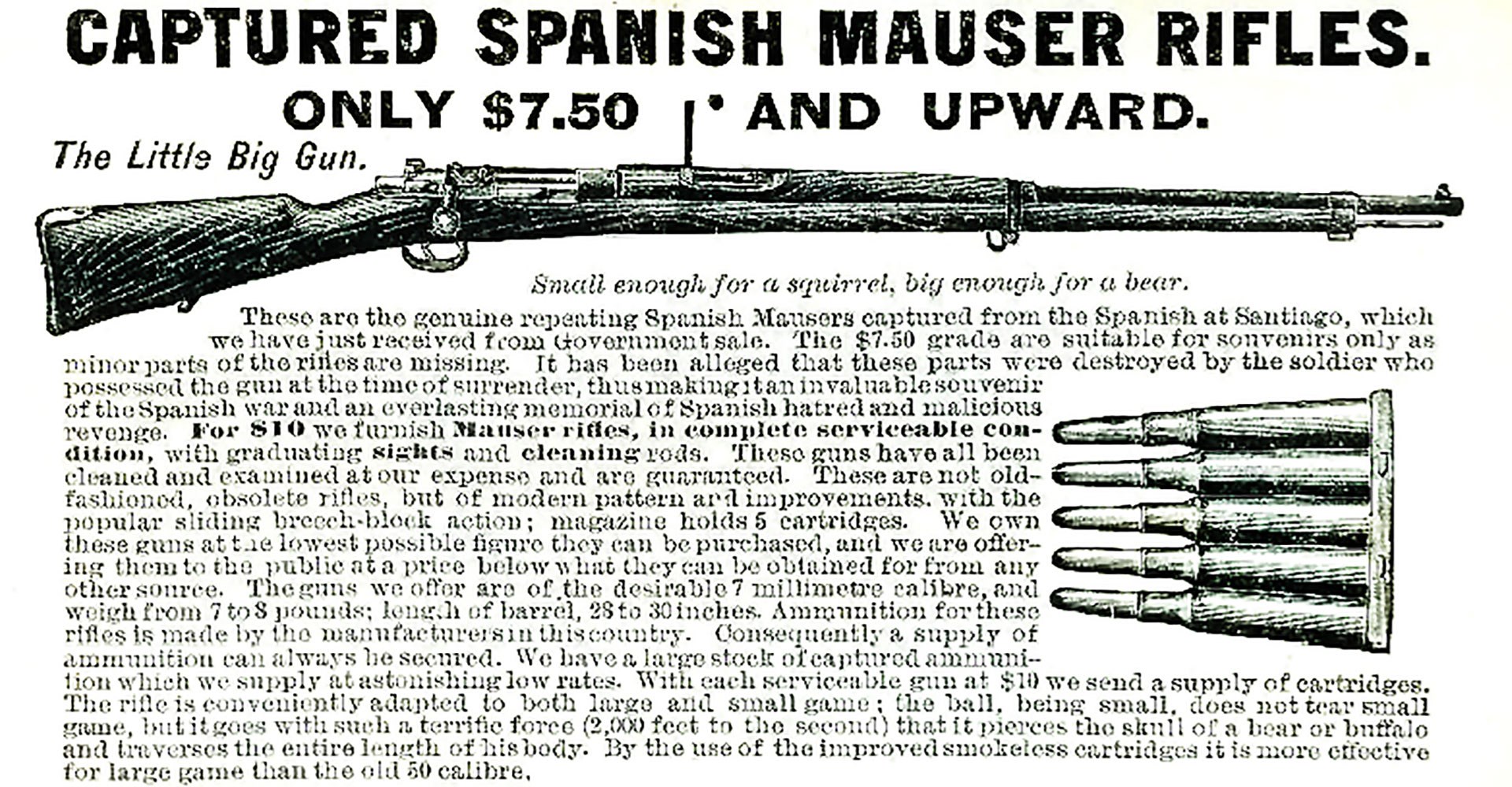 A Bannerman ad for captured Spanish 1893 Mauser rifles following the Spanish-American War.
A Bannerman ad for captured Spanish 1893 Mauser rifles following the Spanish-American War.
The U.S. Army gave the 1893 Mauser a good looking over, and soon after, they began working on a new rifle that closely followed the Mauser design. The Springfield 1903 was so close, in fact, that it was determined that it infringed on several patents held by Mauser (who patented all its innovations in the U.S., too). Mauser and the U.S. government cordially negotiated a settlement for seven patent infringements that ranged from the Springfield’s box magazine to its extractor to its clip-loading system.
After a negotiated settlement, the U.S. agreed to pay the company a royalty on each ‘03 Springfield rifle and ammunition clip produced. This amounted to 75 cents per rifle and 50 cents per 1,000 loading clips manufactured up to $200,000, an amount reached by 1909. Mauser was very familiar with this arrangement, as many of their designs were licensed and manufactured by government arsenals, who paid the company a royalty.
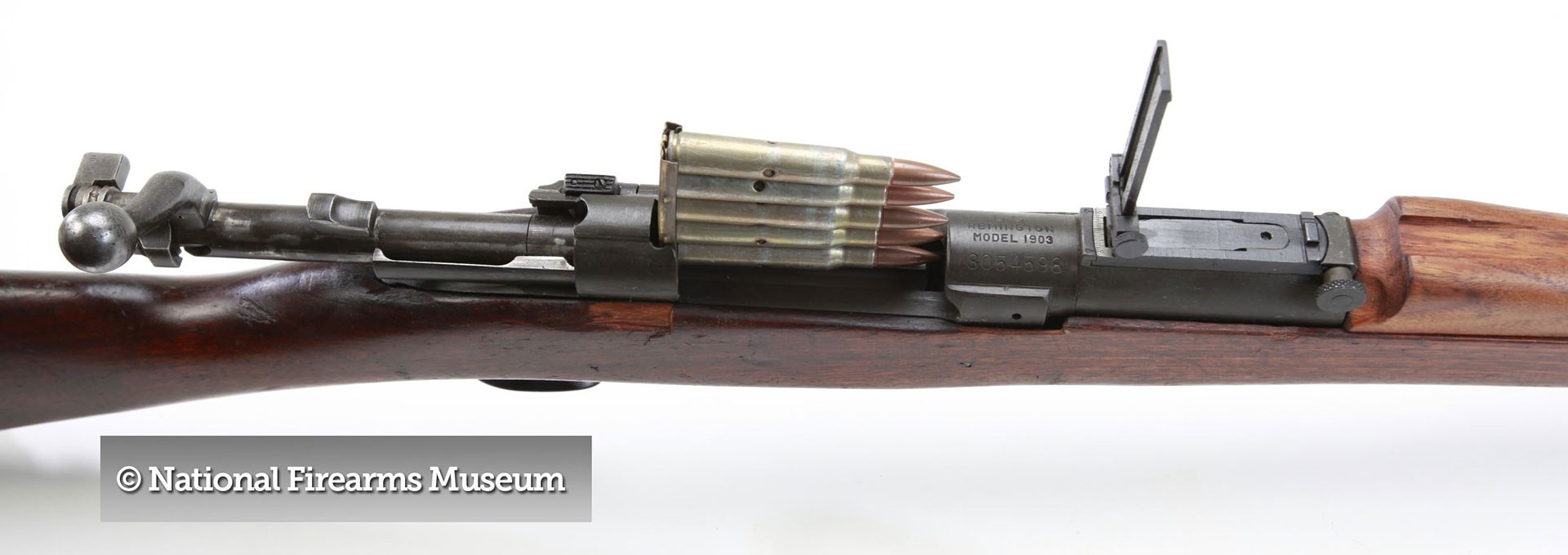 A 1903A1 Springfield rifle, manufactured by Remington, showing the stripper clip of cartridges inserted.
A 1903A1 Springfield rifle, manufactured by Remington, showing the stripper clip of cartridges inserted.
The Mauser-based ‘03 Springfield would continue to serve U.S. forces as a front-line combat rifle through World War II and as a sniper rifle through the Vietnam War. The British had their own experience of facing the withering fire of a Mauser in the Boer War. This caused them to add a clip (which the British called a “charger”) loading feature to their Lee-Enfields and led to experimentation with a Mauser-based rifle of their own, which would eventually become the U.S. P-17 Enfield.
Two: One Of The Biggest Fans of Mauser Designs Was China
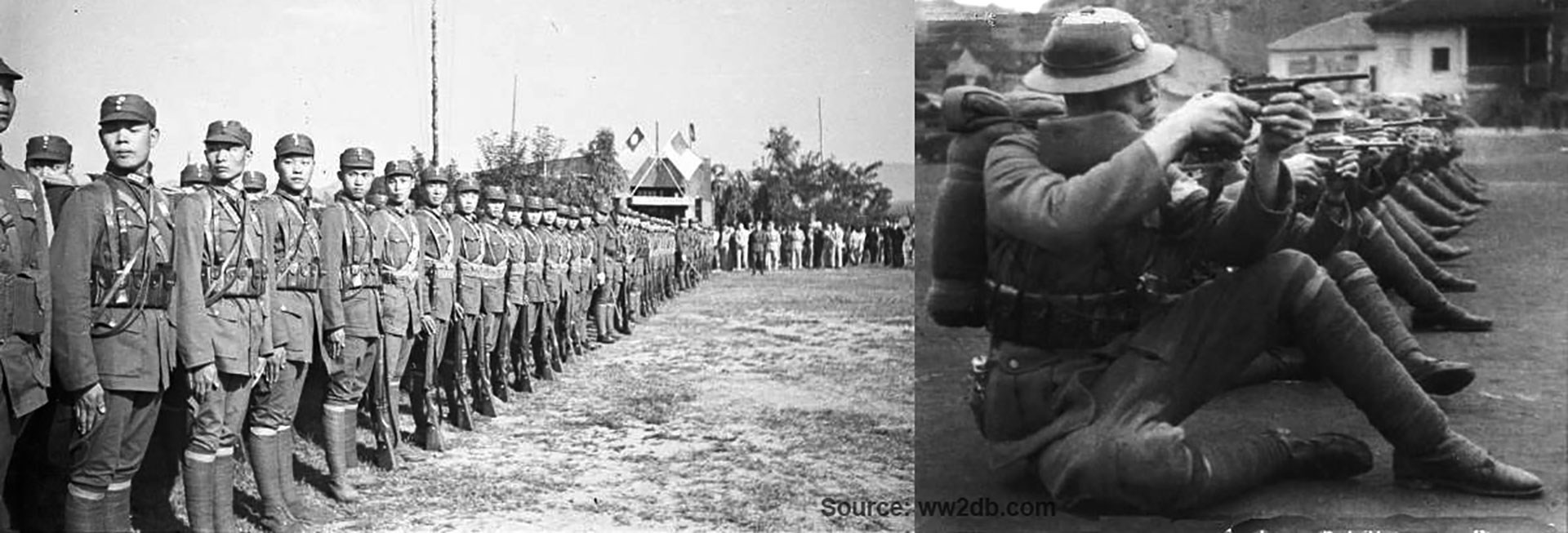 Chinese
troops training with C96 pistols with shoulder stocks (right) and
Chinese troops with CZ vz.24 Mauser 98-type rifles (left).
Chinese
troops training with C96 pistols with shoulder stocks (right) and
Chinese troops with CZ vz.24 Mauser 98-type rifles (left).
One of the earliest modern firearms used by China was the single-shot Mauser Model 1871, which they first purchased in 1876, followed by the repeating 71/84 version. Starting in 1894, China began buying the ‘88 Commission rifle which, though not a Mauser, would be one of the most prolific bolt action designs used by that country. Yet they continued to look for more modern bolt-action rifles, and in 1896, they would purchase some Model 1895 Mausers in 7 x 57 mm.
In the early 1900s, the Chinese began a trial for a new rifle, which was eventually won by a 1907 Mauser, an export version of the Gewehr 98 that was chambered in a special 6.8 x 57 mm cartridge. The 1911 Revolution interrupted the new cartridge’s full adoption and the country ended up sticking with the 8 x 57 mm for most of its weapons.
The C96 Broomhandle pistol was also extremely popular in China. When the Chinese couldn’t get enough of the pistols from Germany, they began to import copies from Spain. Spanish firms, like Astra, took the C96 concept one step further by making fully-automatic versions that, when combined with a shoulder stock, could serve as a rudimentary submachine gun. In response, Mauser introduced their own fully-automatic Broomhandle, the Model 712 Schnellfeuer-Pistole (“Rapid-fire Pistol”).
 A
Mauser Model 712 Schnellfeuer-Pistole with shoulder stock attached and
detachable 20-round magazine. The selector switch for semi-automatic or
fully-automatic fire can be seen.
A
Mauser Model 712 Schnellfeuer-Pistole with shoulder stock attached and
detachable 20-round magazine. The selector switch for semi-automatic or
fully-automatic fire can be seen.
The Chinese also made indigenous copies of the C96, including some chambered in .45 Auto to complement the Thompson submachine guns they were also fond of.
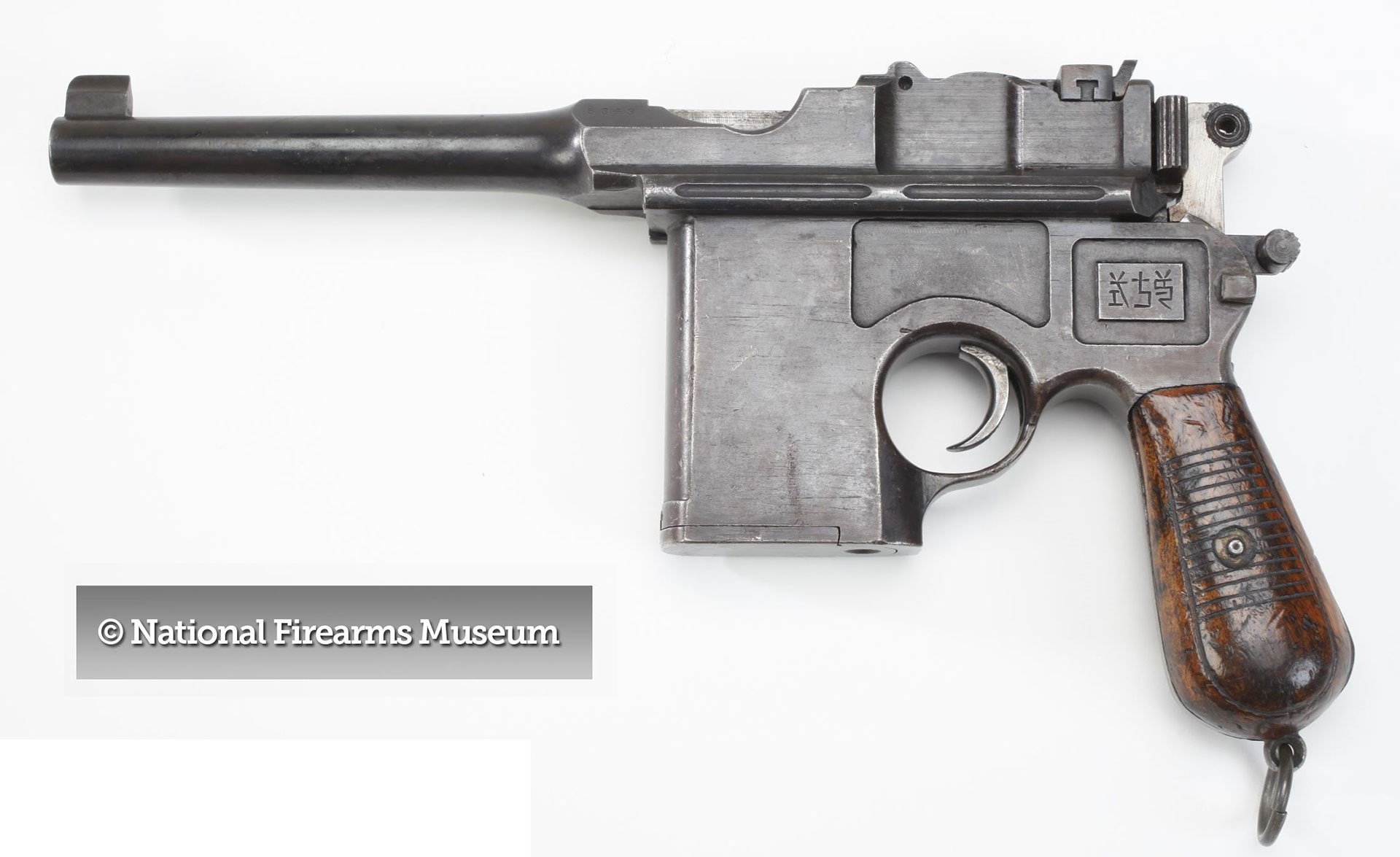 A copy of the C96 Mauser in .45 Auto made at the Chinese Shangshei Arsenal.
A copy of the C96 Mauser in .45 Auto made at the Chinese Shangshei Arsenal.
World War I made the Chinese realize that they couldn’t rely on foreign countries for their armaments, and they began producing many of their small arms domestically, including copies of the ‘88 Commission and Mannlicher 1904 rifles and the 1907 Mauser to supplement what they could import.
When the Versailles Treaty prohibited Mauser from exporting firearms, the Chinese had to look elsewhere for new rifles. They purchased 190,000 FN rifles of the Mle. 24 and 30 patterns and 200,000 CZ vz. 98/22 and vz. 24 rifles in the 1930s. Right before World War II started, they were once again able to purchase Mausers and bought “Standardmodell” export rifles. Like earlier Mausers, these newer designs, specifically the FN Mle. 30 and Standardmodell (which would be known as the “Chiang Kai-Shek rifle," with more than half-a-million made) were manufactured domestically.
 A Model 1898 Mauser rifle made at the Chinese Mukden Arsenal.
A Model 1898 Mauser rifle made at the Chinese Mukden Arsenal.
Following the Communist Revolution, the People’s Republic of China began to adopt Soviet firearms designs, while Nationalist China (Taiwan) would continue using Mausers until they could be replaced by American-supplied weapons. Chinese Mausers, however, would soldier on, being used in the Korean War and eventually in the Vietnam conflict.
Three: Mauser Started Experimenting With Semi-Auto Rifle Designs Well Before WWII (And Even Before World War I)
While the German Army would start and finish World War II with the Mauser 98K as their standard service rifle, early in the war, they recognized the need for a “selbstlader” (“self-loader”) battle rifle and they started experimenting and issuing several designs. In 1941, both Mauser and Walther came up with competing designs, both of which used the Bang muzzle gas trap principle to operate the action.
 A
G41(M) semi-automatic rifle made by Mauser. Note the bolt handle, which
allowed the rifle to be operated as a manual repeater.
A
G41(M) semi-automatic rifle made by Mauser. Note the bolt handle, which
allowed the rifle to be operated as a manual repeater.
While the Walther design won out, the rifle was not without its problems and would lead to the much-improved G43 and eventually, to the revolutionary, intermediate cartridge firing, selective-fire Sturmgewehr. Mauser continued experimenting with autoloading designs. Though none would be adopted, they resulted in the development of the famous roller-delayed blowback system.
Mauser’s experimentation with semi-automatic rifles, however, started nearly half-a-century earlier. In 1898, Mauser made a series of patents for recoil-operated designs, with a rifle using those principles appearing in the same year.
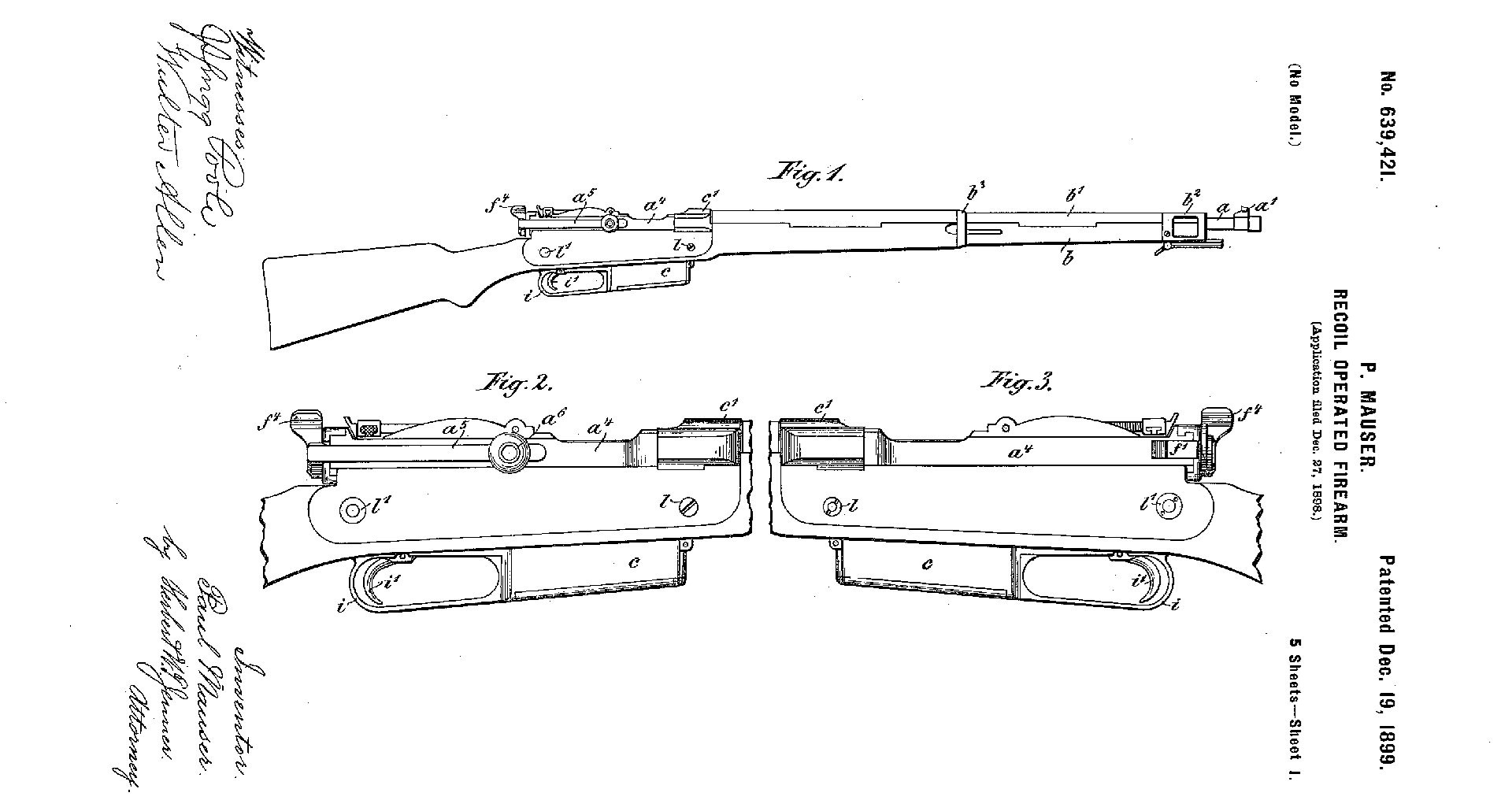 An 1899 patent for a recoil-operated Mauser semi-automatic military rifle.
An 1899 patent for a recoil-operated Mauser semi-automatic military rifle.
 The Mauser C98 Selbstladegewehr, the first semi-automatic rifle made by Mauser.
The Mauser C98 Selbstladegewehr, the first semi-automatic rifle made by Mauser.
Mauser produced several versions of a recoil-operated rifle in the first decade of the 20th century, which the German military evaluated but never adopted. A few sporting semi-auto rifles were also made.When World War I started, a use for a semi-automatic rifle did arise. The early days of air warfare brought the need to arm aircraft crews with a fast-firing weapon. In 1915, Mauser produced a semi-automatic “Fliegermodell” carbine that was chambered in 8 mm and used a 25-round magazine (the U.S. tried a similar concept with their bolt-action 1903). The complicated and expensive to produce rifle was quickly replaced by aerial machine guns.
 A Mauser Model 1916 Flieger-Selbstladekarabiner.
A Mauser Model 1916 Flieger-Selbstladekarabiner.
Four: Mauser Produced the First Anti-Tank Rifle…It Did and Didn’t Influence The Development of the .50 BMG
One of the innovations to appear on the World War I battlefield was a heavily armed and armored vehicle, codenamed the “tank.” As tanks slowly became successful on the battlefield in late 1917, methods to counter them were developed. Because tanks could withstand even armor-piercing rounds from conventional cartridges, something more powerful was needed.
Mauser answered the call with the world’s first anti-tank rifle, called the “Panzerjäger” or “Tank Gewehr.” The rifle was basically a single-shot, oversize Model 98 that was 66.5” long and weighed 41 lbs. It fired a 13.25 mm (0.52”) semi-rimmed cartridge that had been designed as a heavy machine gun round, which launched its 809-grain hardened steel core bullet at 2,575 f.p.s. The cartridge, called the “TuF” (“Tank und Flieger” - "tank and aircraft") could penetrate about an inch of hardened steel tank armor at 100 yards (if struck at a perfect right angle), more than adequate to deal with the tanks of the day. Nearly 16,000 T-Gewehrs would be produced by the war’s end.
 A Mauser Tank Gewehr compared to a Mauser 98AZ carbine (foreground).
A Mauser Tank Gewehr compared to a Mauser 98AZ carbine (foreground).
While the anti-tank rifle concept would survive into World War II, with designs like the British Boys and the Polish wz. 35, by the 1940s, most tanks had evolved their armor to resist even the strongest of shoulder-fired cartridges.
As its name implied, an extra large cartridge like the 13 mm TuF was intended for use against aircraft as well. While the German MG18 machine gun that the TuF round was developed for never made it to the battlefield, other heavy machine gun designs did. A Hotchkiss machine gun was chambered for the 11 mm Gras cartridge, whose heavy bullet had space to hold incendiary compounds to be used against observation balloons and aircraft. Vickers would also chamber an aircraft machine gun in the Gras cartridge.
While the cartridge that would later become the .50 BMG and the Browning machine gun designed to fire it were already being developed before the Allies encountered the Tank Gewehr on the battlefield, the success of Mauser’s anti-tank rifle certainly encouraged the U.S. to continue to develop the Browning .50 after the war ended as an effective cartridge to deal with vehicles and aircraft.
John Browning would chamber the cartridge in a scaled-up version of his M1917 water-cooled machine gun that would eventually evolve into the air-cooled M2, a weapon still in frontline service with the U.S. and other nations around the world. The .50 BMG would also play a critical role in World War II’s air war. Modern rifles chambered for the .50 BMG cartridge, while not used against tanks, are highly effective in sniping and anti-material roles.
Five: Mauser Actions Formed the Backbone of the British Custom Rifle Industry and the Rest of the Hunting Rifle World
When most people think of British sporting rifles, a finely-made double rifle is what comes to mind. Bolt action “magazine rifles” were also an important part of the British custom rifle industry, and the Mauser 98 action was the basis of many of those rifles.
At the turn of the 20th century, the new bolt action rifles provided an affordable alternative to hand-built single-shot and double rifles, while still being strong, accurate and reliable. The success of Mauser’s factory-produced sporting rifles, especially in hard-hitting calibers like the 9.3 x 62 mm, led British makers to pursue their own turn bolt rifles.
While other types of bolt-actions were also used by British makers, such as the Mannlicher (with both Mannlicher en-bloc clip magazines and the Schoenauer rotary magazine) and the Lee, the Mauser was the most popular. By 1900, the John Rigby firm of London was Mauser’s agent in England. Mauser-based sporting rifles were made by Bland, Cogswell & Harrison, Gibbs, Greener, Holland & Holland, Jeffery, Purdey, Westley Richards and many others. At Rigby’s request, Mauser even designed a lengthened “Magnum” version of its action, which allowed for the development of famous hunting cartridges like the .300 and .375 H&H, .416 Rigby, .404 Jeffery and .505 Gibbs.
 A Holland & Holland rifle in .375 H&H that uses a Mauser Model 98 action.
A Holland & Holland rifle in .375 H&H that uses a Mauser Model 98 action.
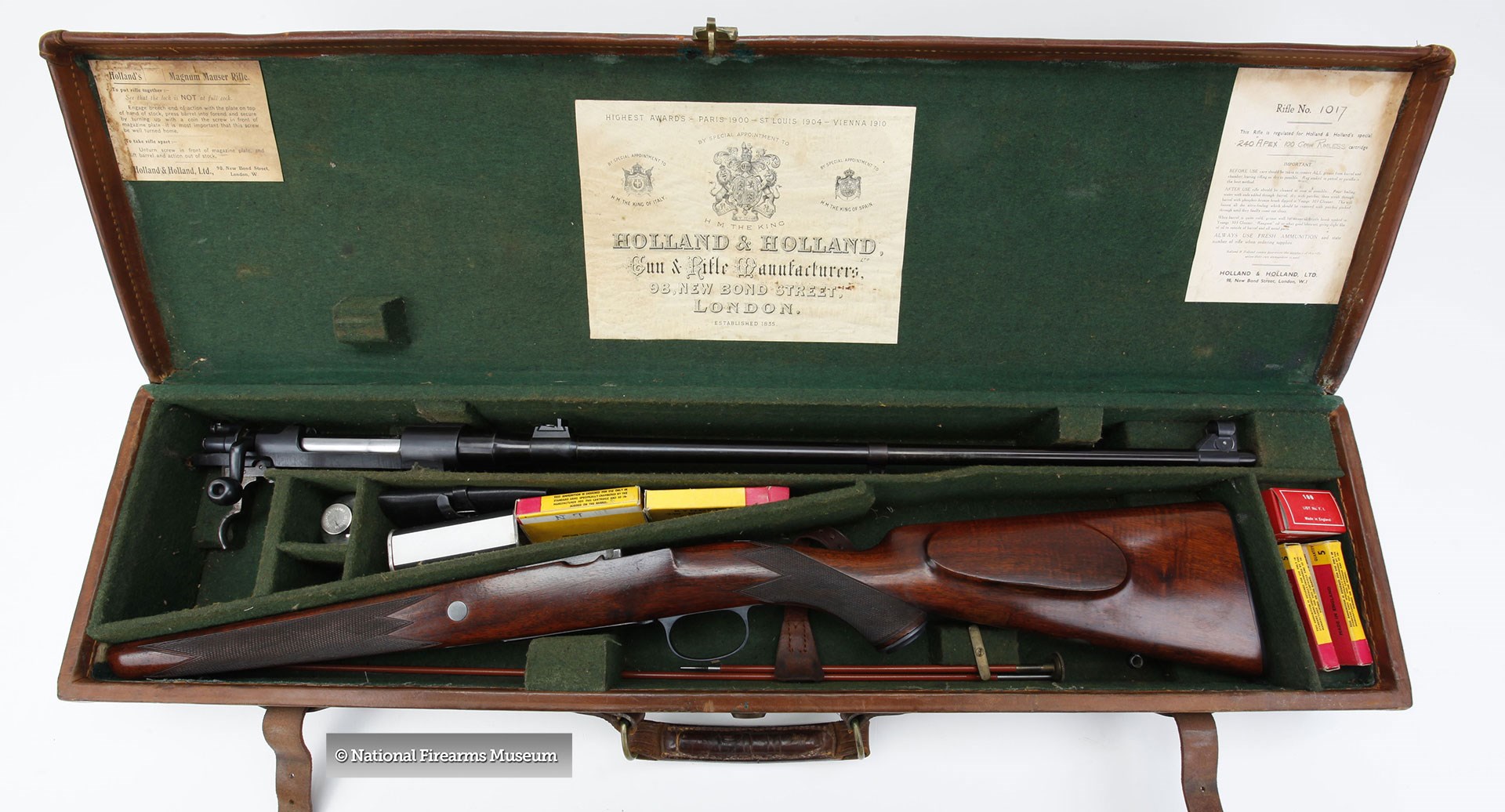 A cased Holland & Holland takedown rifle that uses a Mauser Model 98 action.
A cased Holland & Holland takedown rifle that uses a Mauser Model 98 action.
The influence of the Mauser 98 action on sporting rifles didn’t stay on one side of the Atlantic. American hunters and shooters were begrudgingly weaned off their lever actions through their exposure to Mauser-based bolt action designs, such as the ‘03 Springfield. When Winchester set about to develop their Model 54 (predecessor to the “Rifleman’s Rifle” Model 70), the company looked to the Mauser.
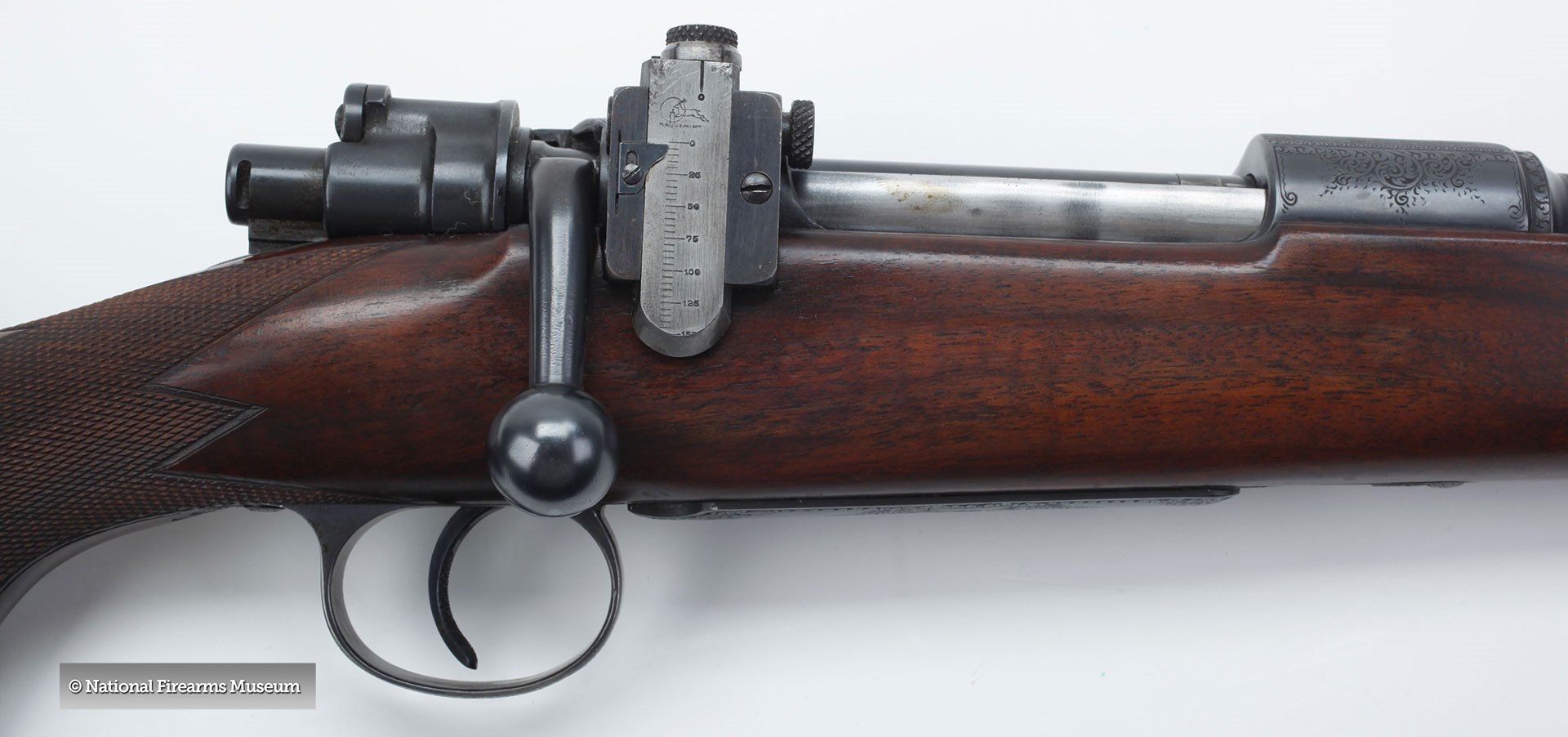 Close-up of the Mauser 98 action used on a Griffin & Howe custom rifle.
Close-up of the Mauser 98 action used on a Griffin & Howe custom rifle.
Remington’s first modern bolt-action sporters, such as the Model 30, were derived from the Mauser-based P-17 Enfield. American custom makers, like Griffin & Howe, used 98 actions and the design’s controlled-round-feed extractor became the standard for dangerous game rifles. Today, Mauser 98-actioned sporting rifles can be had from Mauser themselves, as well as companies like CZ and Zastava.
Six: Mauser Made Cars
Everyone knows that FN made bicycles and motorcycles, but did you know that Mauser made cars? When the terms of the Versailles Treaty prevented the company from making and exporting firearms they looked into other manufacturing fields. Their company’s first automotive model was the Einspur-Auto (“Single Track”). As much motorcycle as car, the Einspur-Auto used a tandem set of wheels with two outriggers that retracted when the vehicle got up to speed.
Powered by the M2B15, the first version of BMW’s famous air-cooled Boxer twin, its driver and passengers sat in an open, boat-like cockpit. It was produced from 1923 to 1929. Mauser also made a more conventional four-wheeled car, the 6/24 Mauserwagen that was offered as a sedan or open-top model, from 1923-1927.
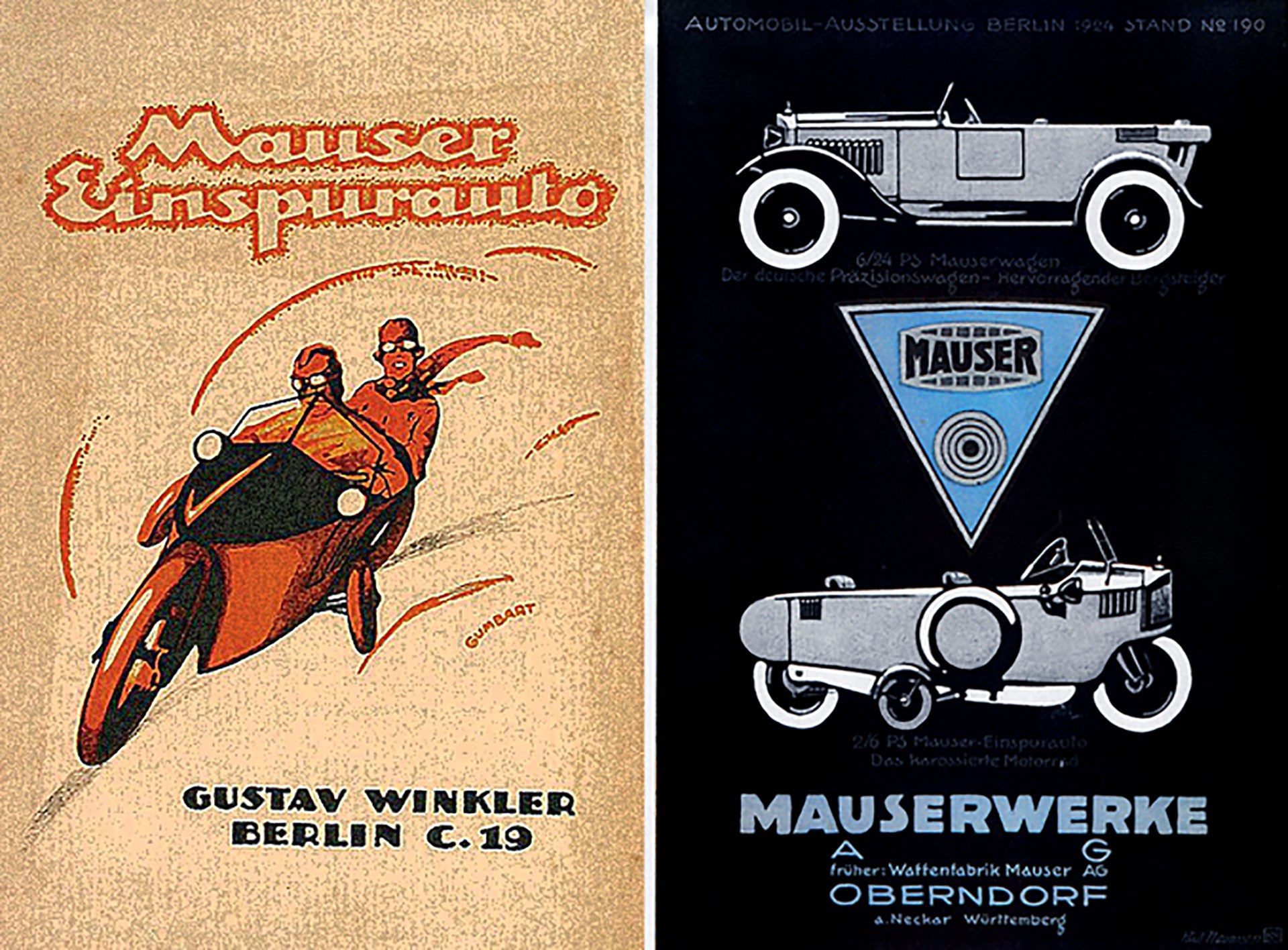 Advertisements for Mauser automobiles.
Advertisements for Mauser automobiles.
Seven: Mauser Designed and Built Machine Guns and Cannons
In addition to rifles and handguns, Mauser also designed and built machine guns and automatic cannons. World War I made the German military realize the need for a portable, belt-fed machine gun. While the terms of the Versailles Treaty limited German efforts to develop weapons technology themselves, the Rheinmetall-designed MG30 was refined and manufactured by Solothurn in Switzerland.
The magazine-fed MG30 was brought back to Mauser, where engineer Heinrich Vollmer refined it into the MG34. The MG34 was the world’s first successful general purpose machine gun. It was light enough to be transported by one man and fired from a bipod, yet its quick-change barrel and belt feed mechanism meant it could be utilized on a tripod in a sustained fire role.
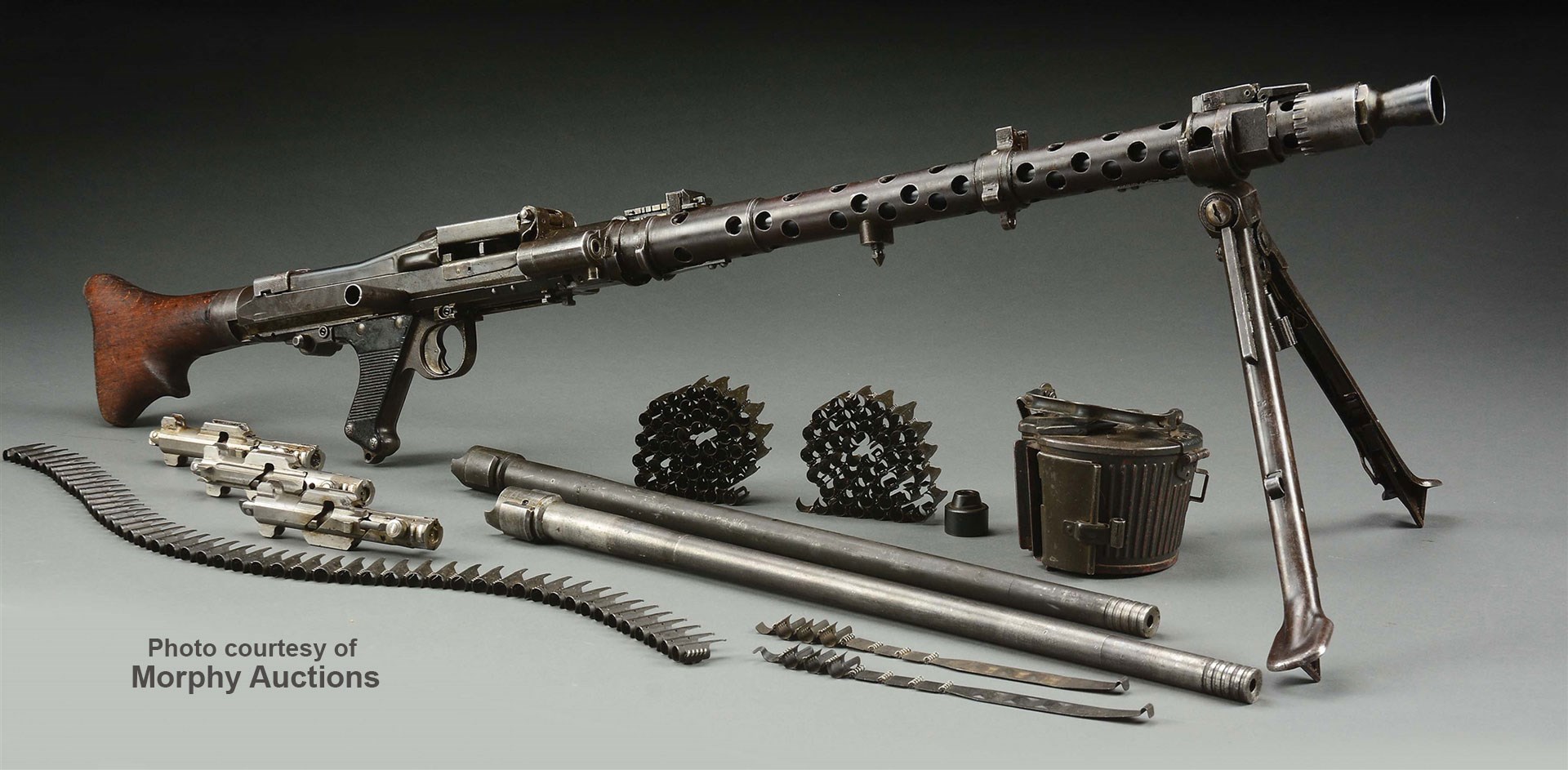 A MG34 with spare parts and barrels.
A MG34 with spare parts and barrels.
The MG34 would be the basis for the MG81, a faster firing version used as a flexible-mounted aircraft machine gun, that was also manufactured by Mauser. The MG 81was used in one, two, four or six gun installations in aircraft such as the Junkers Ju-88, Heinkel He-111 and the Dornier Do-217.
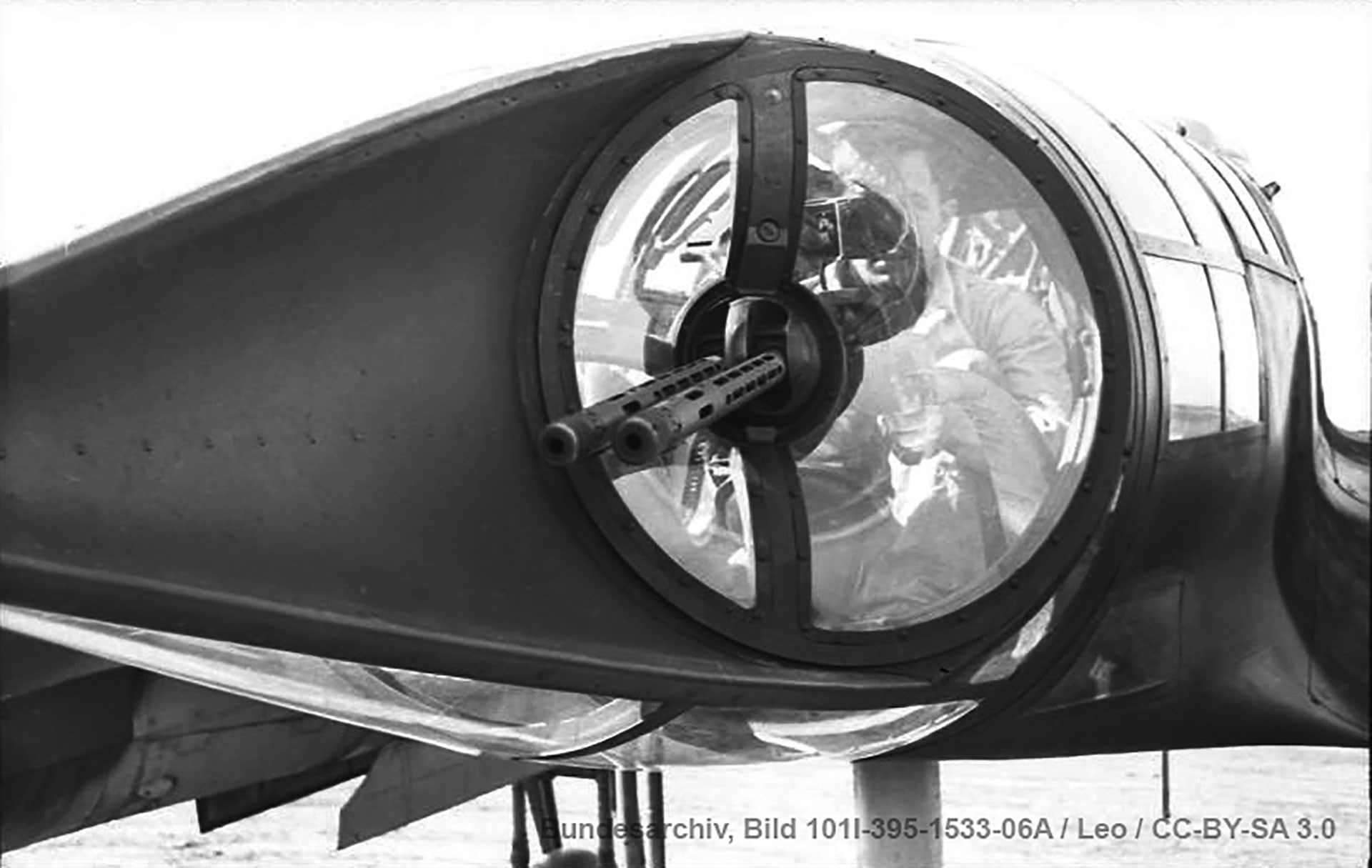 Twin MG 81Z machine guns mounted in rear of the crew gondola of a Focke-Wulf Fw 189 reconnaissance aircraft.
Twin MG 81Z machine guns mounted in rear of the crew gondola of a Focke-Wulf Fw 189 reconnaissance aircraft.
While the MG34 had an excellent service record in the early years of World War II, Mauser and the other factories that produced it could not keep up with demand for the machined steel firearm. The same techniques of using synthetic materials and metal stampings that had been used in guns like the MP40 were applied by sheet metal specialists Grossfuss to the MG34. The result was the MG42. The MG42 was the premier World War II machine gun and was also manufactured by Mauser. It was so successful that the design is still in use today, with modern versions chambered in 7.62 NATO manufactured and deployed around the world.
In addition to fully-automatic small arms, Mauser also designed and built automatic cannons. The MG151 15 mm and 20 mm autocannon was used to arm German and Italian fighter and bomber aircraft, including the Focke-Wulf Fw-190 and Messerschmitt Bf-109.
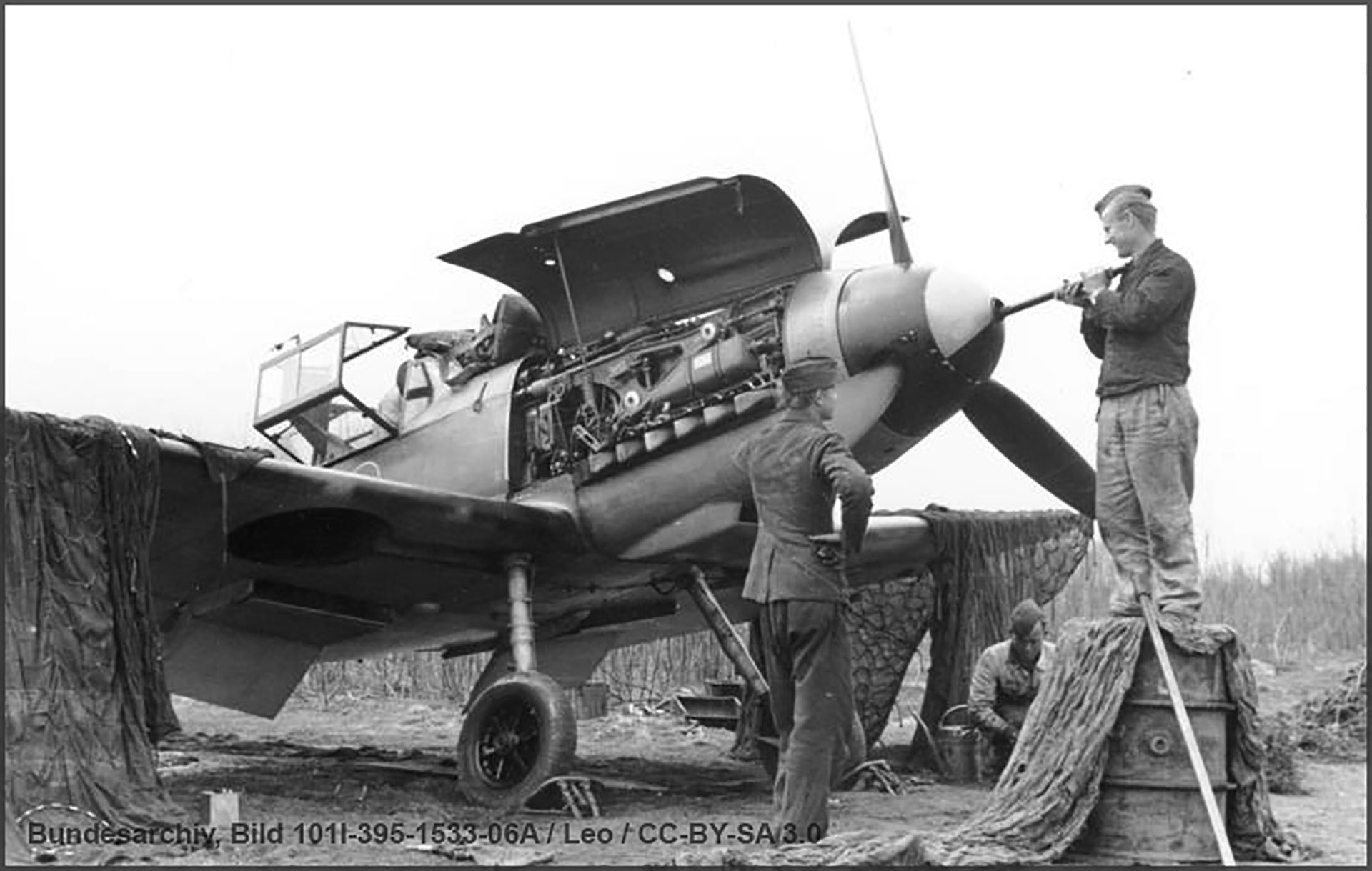 Cleaning the barrel of the automatic cannon on a Messerschmitt Bf 109 in the Soviet Union, January 1942.
Cleaning the barrel of the automatic cannon on a Messerschmitt Bf 109 in the Soviet Union, January 1942.
The Mauser MG 213 20 mm cannon never saw service in World War II but would be developed into the U.S. M39, which was used in aircraft like the F-86 Supersabre and F-5 Freedom Fighter. Mauser also designed ground-based autocannons, such as the single-barreled 20 mm Flak 38 (an example of which is used to devastating effect in the final battle scene of the film Saving Private Ryan). A four-barreled anti-aircraft version, known as the Flakvierling, was also made.
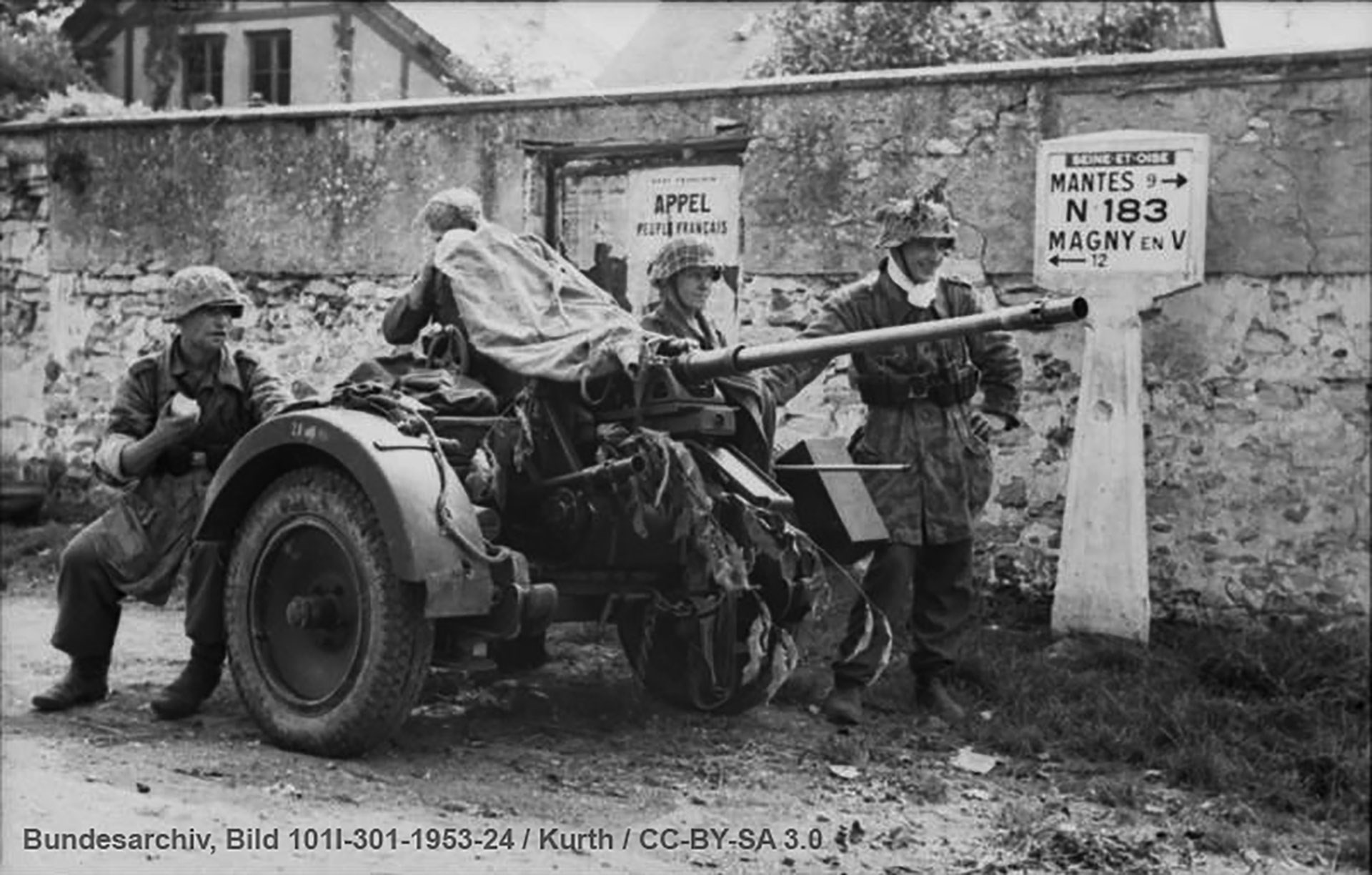 German soldiers with a Flak 30 20mm in northern France in August 1944.
German soldiers with a Flak 30 20mm in northern France in August 1944.
When Mauser re-entered the defense market in the 1970s, they designed and built the BK-27 27 mm revolving cannon for Tornado and Typhoon fighter jets and in the 1990s, the RMK-30, a 30 mm recoilless autocannon used in ground, sea and aerial applications. Both of these systems are still marketed by Rheinmetall.
Eight: Mauser Almost Disappeared After World War II
Portions of Mauser’s factory in Oberndorf were destroyed in 1945 by Allied bombing, and the plant was occupied by the French Army in April of that year. Mauser continued manufacturing firearms for two years, including 98K rifles and HSc pistols for use by the French military. In 1947, the company was ordered to be liquidated and much of its machinery removed and the original factory records destroyed. The Mauser company survived over the next decade making sewing machines and automotive parts.
Mauser returned to the firearm business in 1965 with the Walter Gehmann-designed Model 66. The Model 66 was a departure from pre-war Mausers. It utilized a short action telescoping bolt and interchangeable barrel system. More conventional bolt action sporting rifles were made for Mauser by Heym. Production of HSc and Luger pistols also resumed.
Mauser continued to develop their line of bolt action rifles over the years, introducing the rear-locking-lug Model 77. They produced a line of precision sniping rifles and even dabbled with a straight-pull design in the Model 96 (currently manufactured by Roessler as the Titan 16).
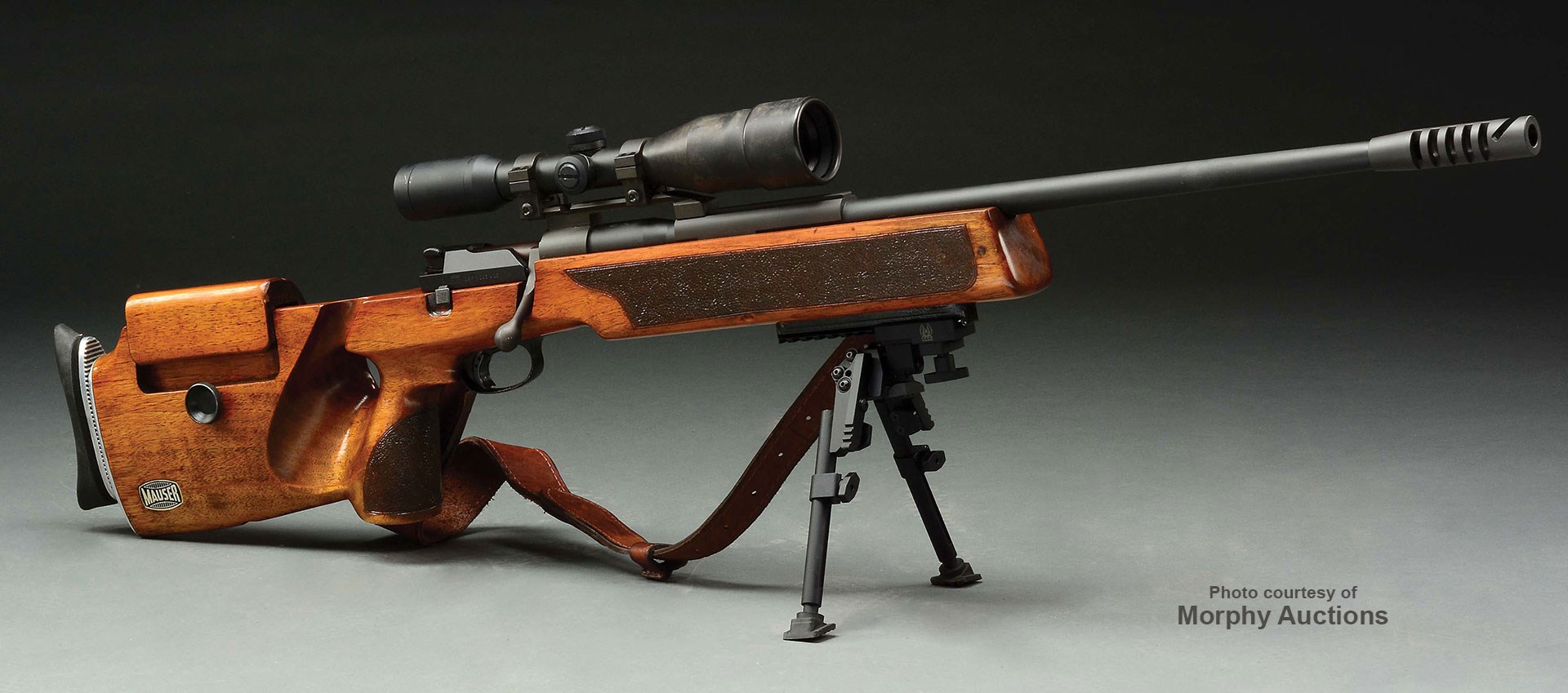 A Mauser SP66 sniper rifle used by Israeli forces.
A Mauser SP66 sniper rifle used by Israeli forces.
In 1994, Mauser became part of the Rheinmetall group, with the sporting firearm business being spun off into its own entity. Sporting rifles are currently made by Mauser Jagdwaffen Gmbh and include the M12 and the M18 (named the American Rifleman Golden Bullseye Rifle of the Year in 2020) and the classic Model 98.
Nine: Heckler & Koch, and Their Roller-Delayed Blowback System, Got Their Start At Mauser
Following World War II, former Mauser employees Edmund Heckler, Theodor Koch and Alex Seidel joined together to form Heckler & Koch, a machine tool and engineering firm in Mauser’s home town of Oberndorf.
H&K returned to their firearms roots when the German Army was in the market for a new infantry rifle. They took on the Spanish CETME design, based on the roller-delayed blowback concept that Mauser was perfecting at the end of World War II, and refined it into a rifle that Germany would adopt as the G3. The G3 would go to become one of the world’s most prolific battle rifles ever made, with more than eight million produced.
 A
diagram of the roller-delayed blowback mechanism of the G3 rifle, as
invented by Mauser, perfected by CETME and made successful by
Heckler& Koch.
A
diagram of the roller-delayed blowback mechanism of the G3 rifle, as
invented by Mauser, perfected by CETME and made successful by
Heckler& Koch.
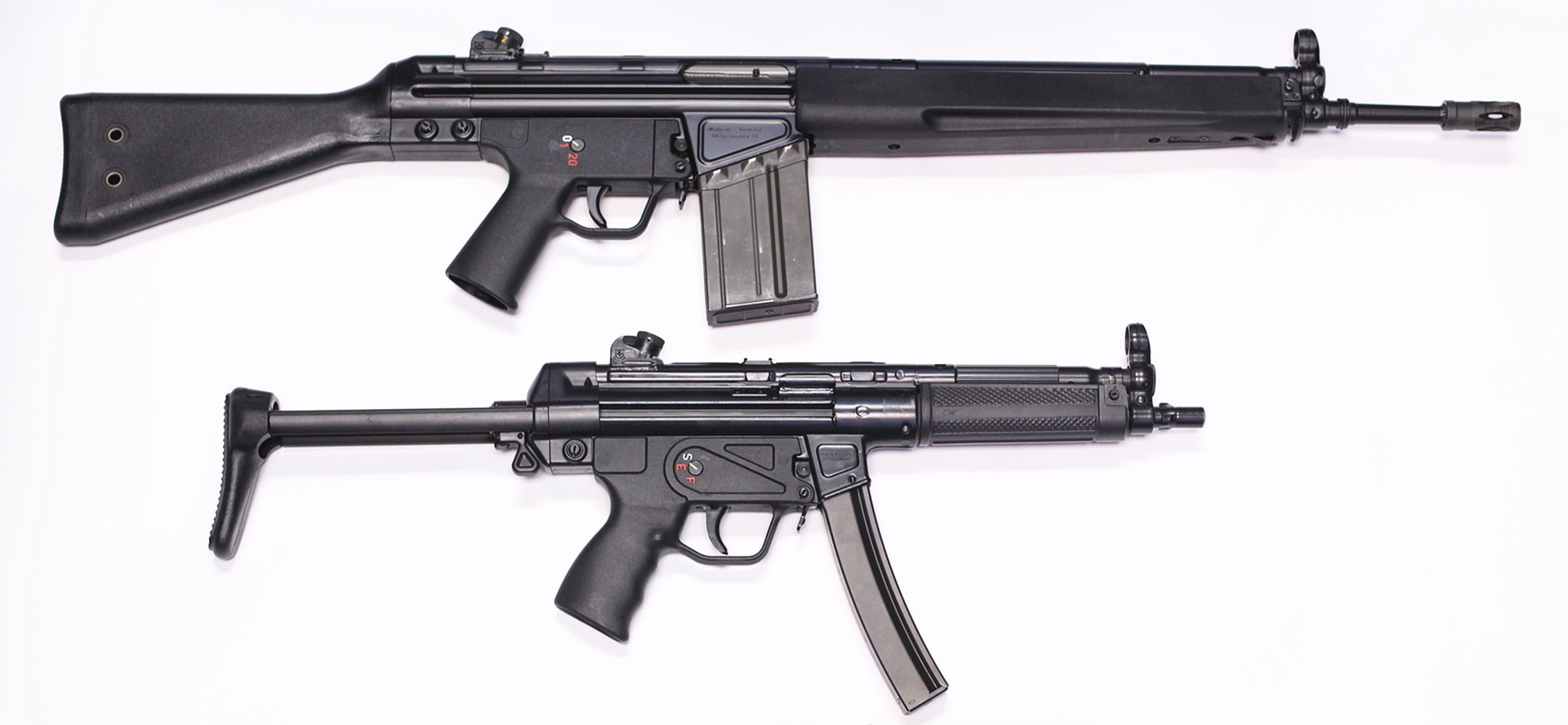 Heckler
& Koch scaled the roller-delayed blowback design to a variety of
firearms, from the 7.62 mm NATO G3 rifle (top) to the 9 mm Parabellum
MP5 submachine gun (bottom).
Heckler
& Koch scaled the roller-delayed blowback design to a variety of
firearms, from the 7.62 mm NATO G3 rifle (top) to the 9 mm Parabellum
MP5 submachine gun (bottom).
Heckler & Koch took the roller-delayed principle and scaled it to a variety of firearms, from belt-fed machine guns to precision rifles to handguns and to submachine guns, in the form of the famous MP5.
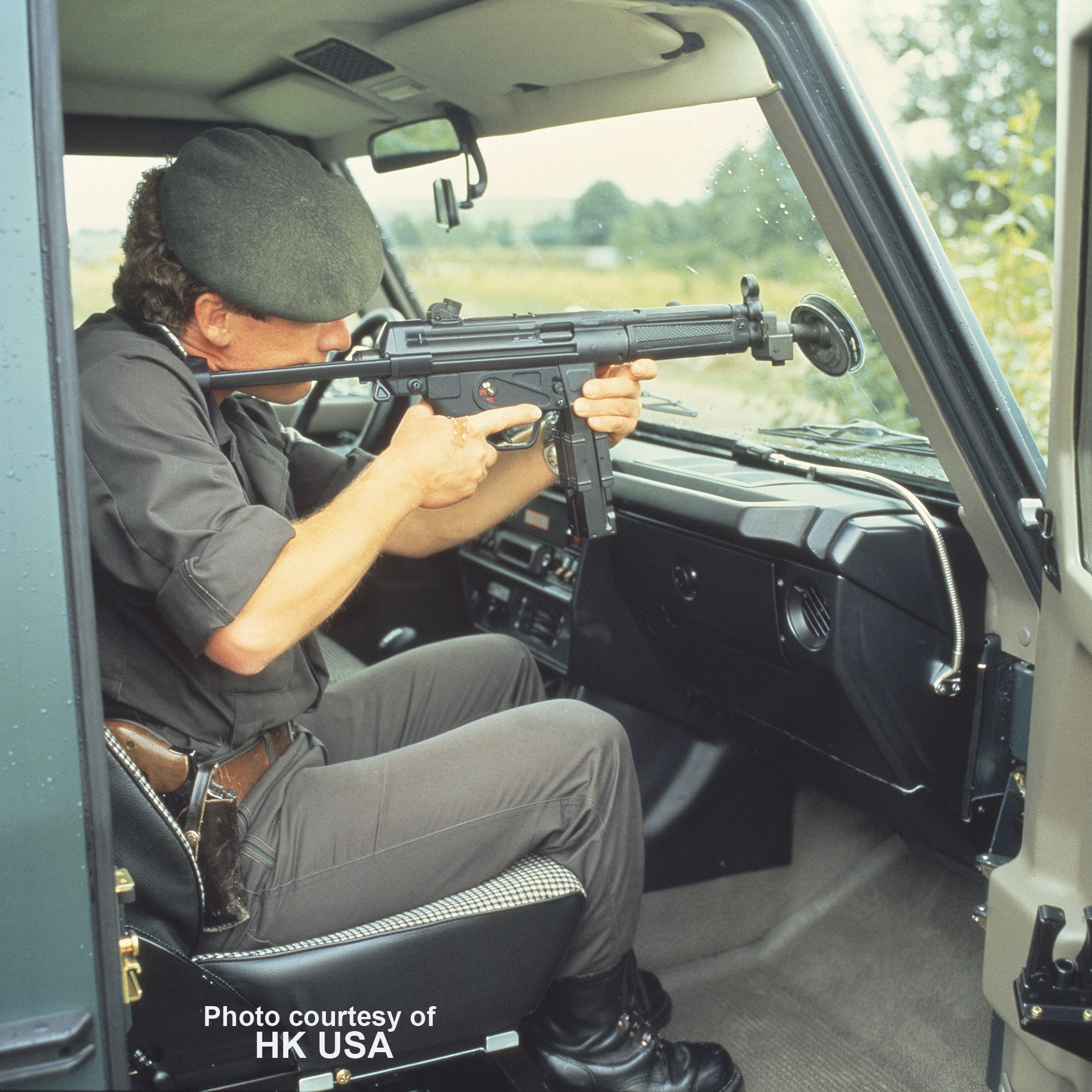 One
of the most famous applications of the Mauser-invented roller-delayed
blowback mechanism is in the Heckler & Koch MP5 submachine gun, as
seen here in the hands of a German GSG-9 operative.
One
of the most famous applications of the Mauser-invented roller-delayed
blowback mechanism is in the Heckler & Koch MP5 submachine gun, as
seen here in the hands of a German GSG-9 operative.
In the 1970s, H&K moved away from the roller-delayed principle in handguns with innovative designs like VP70, a polymer-framed pistol that used an 18-round double-column magazine, and the gas-delayed blowback, “squeeze cocking” P7. From its humble origins rising from the ashes of Mauser, Heckler & Koch has grown into one of the world’s leading firearms manufacturers, with contemporary products like the HK416 or MR556, the VP9 and the G36.
Ten: The Mauser Model 1898 is One of the Most Produced and Influential Firearms Designs of All Time
 The most successful turn-bolt rifle design ever, the Mauser Model 1898, shown in its Gewehr 98 form.
The most successful turn-bolt rifle design ever, the Mauser Model 1898, shown in its Gewehr 98 form.
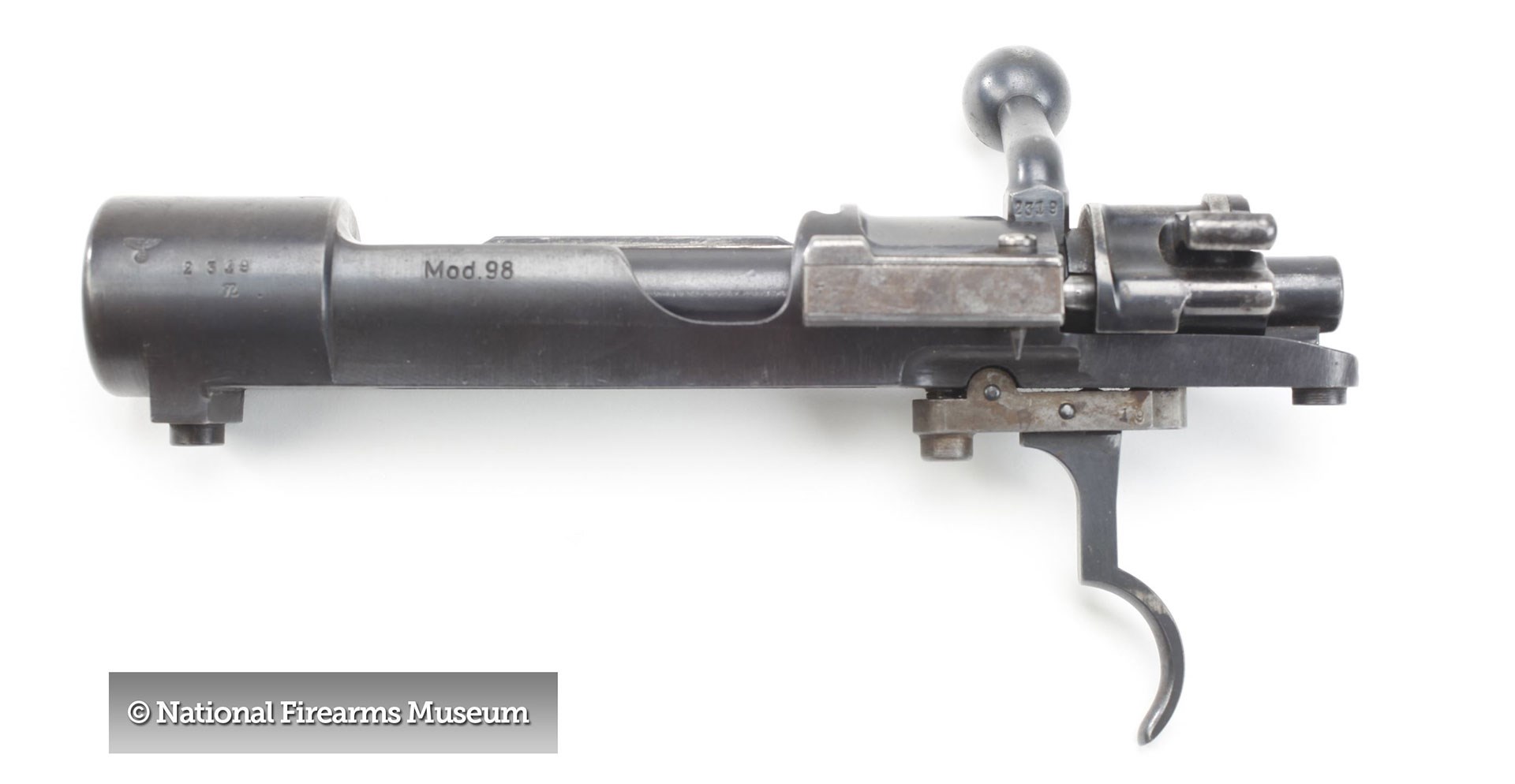 A Mauser Model 98 receiver and bolt.
A Mauser Model 98 receiver and bolt.
That the Mauser 98 is one of the most produced and influential designs of all time is certainly not a little known fact, but it bears repeating at the summation of this series. Mauser 98 rifles and copies are probably the second most widely- produced firearm design, after the AK-47 and its derivatives. Conservative estimates put production of Mauser 98-type rifles at over 100 million, approximately 10 times the total number of Glock handguns produced to date. Mauser’s heritage lives on in nearly every modern turn bolt rifle and in the company’s own contemporary products, like the M12 and M18.
Truly a timeless design, much like the 1911.
ReplyDelete